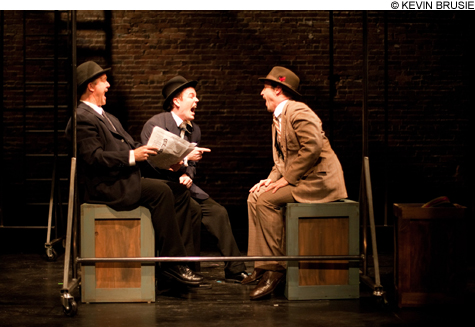
IN THE TRAIN CAR Creative staging and hilarity. |
The driving force of Hitchcock's 1939 film The 39 Steps is suspense, as unwitting bachelor Richard Hannay gets caught up in espionage, train escapes, weapons technology, and the future of Europe and the world. In Patrick Barlow's stage adaptation, however, suspense is decidedly not the raison d'être. Instead, the focus is the chops of four actors who, between them, portray more than 100 of the spy story's characters. A farce of quick-changes and cross-dressing, the play affectionately sends up the tropes of the thriller film by putting it on stage, subjecting it to the theater's own limits and conventions.
Portland Stage Company takes the premise a step farther into meta-land by not just staging it in a theater, but setting it there (as a theater security guard falls asleep while watching the movie), and rakishly calling attention to an array of mannequins and Foley sounds, deliberately missed cues and actors slipping in and out of character: In this comedy, PSC's season opener, director Samuel Buggeln has chosen to send up both the screen and the proscenium.
If that seems a little muddy to you conceptually, you are already thinking way too subtly to appreciate this show. Instead, think slapstick gags and hyperbole, phones that ring off-cue and actors mugging for the audience. Paolo Andino unabashedly overblows leading man Hannay, posing and posturing as a caricature of the dashing hero on the run from the law. Likewise do the three actors who portray his nemeses and allies (Gardner Reed, as three differently accented women, and Torsten Hillhouse and Dustin Tucker in an array of comic duos) pull out all the stops to exaggerate the many types they play.
The gorgeous, dramatic, and very German Annabella (Reed, mellifluous and stunningly garbed by Loyce Arthur) slinks into Hannay's life at a music-hall show (a fine theatrical moment as she enters from the audience, down the steps of the house aisle in a white spot). Before she gets a knife in the back, she leaves enough clues to get him on a train to Scotland, there to meet an evil professor (Tucker) and sundry other hindrances.
They go pursuing and evading each other over a largely bare stage (set designer Anita Stewart features the theater's exposed-brick rear wall for much of the show), often creating their settings with the most rudimentary of devices: an automobile or a train compartment made of stacked crates, a fire made to crackle by a hand from the wings crinkling a piece of plastic. Most cleverly employed is a series of wardrobe racks on wheels, which the ensemble rolls around to indicate walls, doors, and windows.
At its best, The 39 Steps soars on the virtuosity of some very inspired stagecraft and witty parody, executed beautifully by the ensemble. In one exemplary scene, Hannay shares a train compartment, rendered by wardrobe racks, with two lingerie salesmen. Tucker and Hillhouse entertainingly play up these guys as the ultimate in irritating train companions — eating loudly, laughing at their own jokes — and the three perform a delightful little ballet of limbs and elbows in close quarters. When Hannay escapes through the train "window," the subsequent chase scene, Andino's body simulating the effects of the train's speed, is out of this world — a triumph of stagecraft in its purest form.